2007 JEEP PATRIOT traction control
[x] Cancel search: traction controlPage 248 of 440
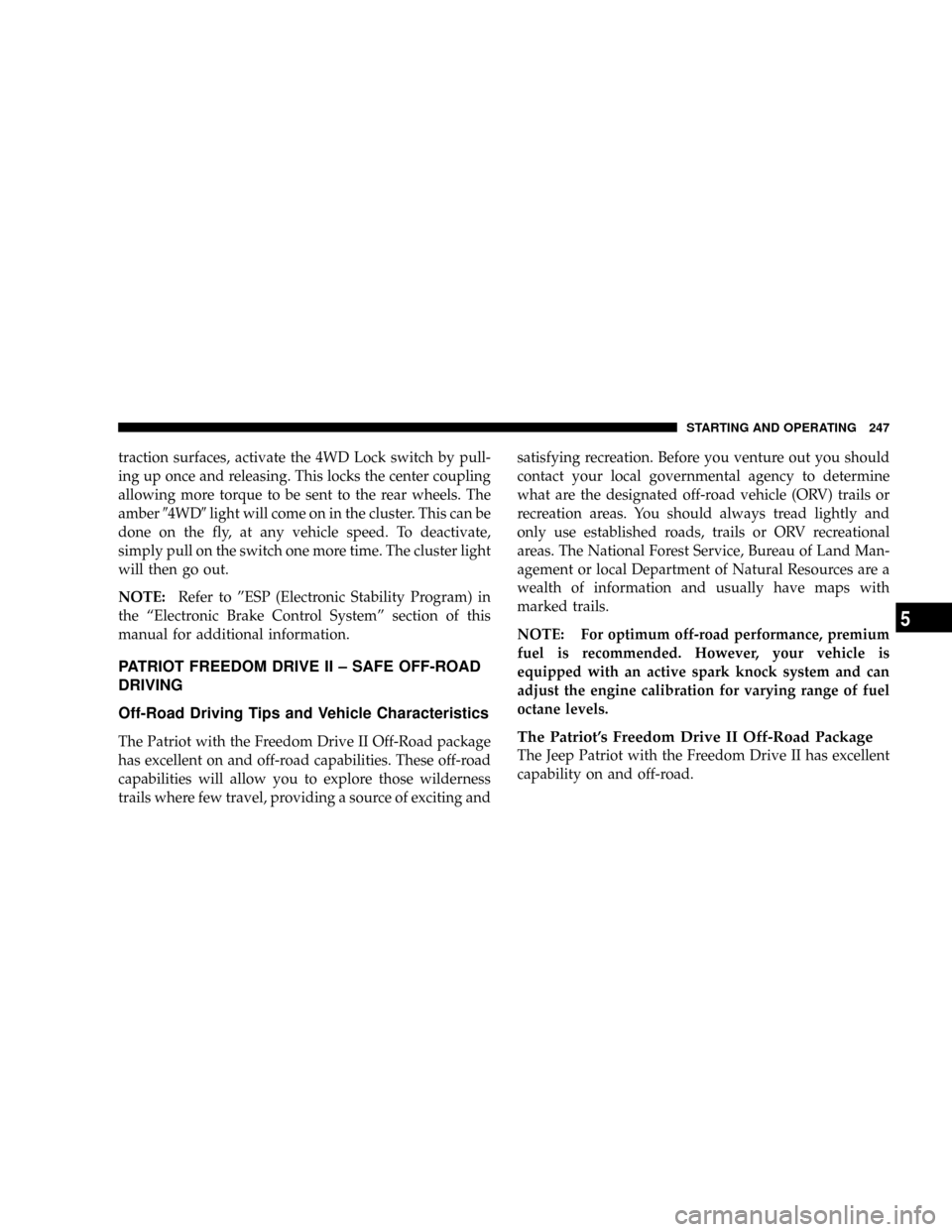
traction surfaces, activate the 4WD Lock switch by pull-
ing up once and releasing. This locks the center coupling
allowing more torque to be sent to the rear wheels. The
amber94WD9light will come on in the cluster. This can be
done on the fly, at any vehicle speed. To deactivate,
simply pull on the switch one more time. The cluster light
will then go out.
NOTE:Refer to ºESP (Electronic Stability Program) in
the ªElectronic Brake Control Systemº section of this
manual for additional information.
PATRIOT FREEDOM DRIVE II ± SAFE OFF-ROAD
DRIVING
Off-Road Driving Tips and Vehicle Characteristics
The Patriot with the Freedom Drive II Off-Road package
has excellent on and off-road capabilities. These off-road
capabilities will allow you to explore those wilderness
trails where few travel, providing a source of exciting andsatisfying recreation. Before you venture out you should
contact your local governmental agency to determine
what are the designated off-road vehicle (ORV) trails or
recreation areas. You should always tread lightly and
only use established roads, trails or ORV recreational
areas. The National Forest Service, Bureau of Land Man-
agement or local Department of Natural Resources are a
wealth of information and usually have maps with
marked trails.
NOTE: For optimum off-road performance, premium
fuel is recommended. However, your vehicle is
equipped with an active spark knock system and can
adjust the engine calibration for varying range of fuel
octane levels.The Patriot's Freedom Drive II Off-Road Package
The Jeep Patriot with the Freedom Drive II has excellent
capability on and off-road.
STARTING AND OPERATING 247
5
Page 249 of 440

The package includes:
²2.4L DOHC 16-Valve I4 (172 bhp @ 6000 rpm, 165 lb-ft
@ 4400 rpm)
²Second generation continuously variable transaxle
(CVT2L) with 19:1 crawl ratio
²Tow Hooks: 2 front and 1 rear
²Front engine and transaxle skid plate
²Fuel tank skid plate
²Air filtration system
²Unique springs for a 1 inch of increased ride height
²Fog lamps
²Seat height adjust
²Three-mode Electronic Stability Program (ESP)
²Hill-descent control
²Unique off-road engine calibration for optimum off-
road performance with premium fuel
²Off-road Brake Traction Control
²Unique off-road Anti-lock brake calibration
²Heavy duty cooling package (Eng/larger CVT oil
cooler, High capacity cooling fans)
²Heavy duty alternator
²Improved body sealing and high located drivetrain
component vents
²Reinforced rear lateral links
Freedom Drive II 4WD System Operation
Under normal driving conditions, the vehicle operates in
the active four wheel drive mode. Pulling up on the 4WD
lock lever activates the 4WD system and lights the amber
4WD cluster light. This commands a higher torque to the
rear wheels, for improved traction capability on slippery
248 STARTING AND OPERATING
Page 250 of 440
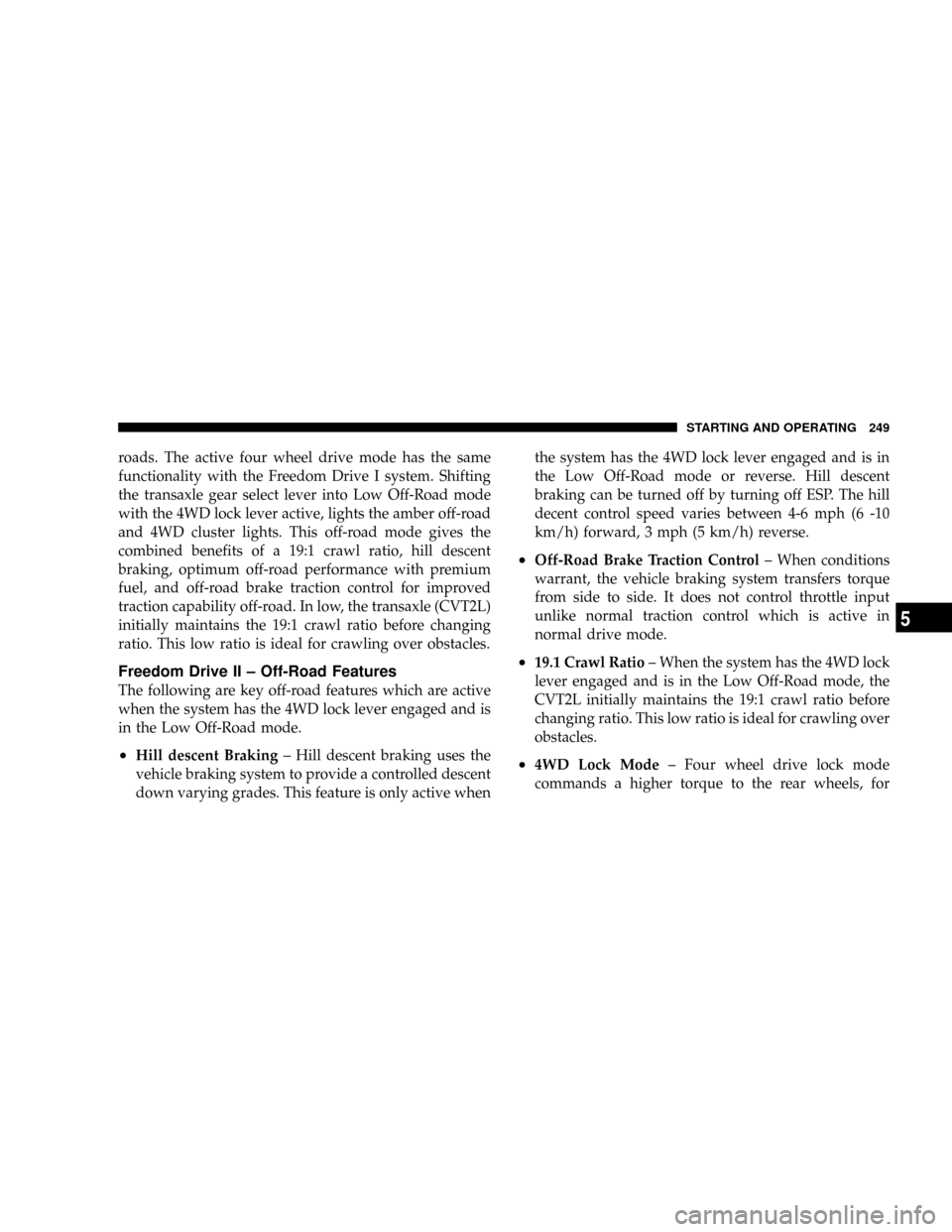
roads. The active four wheel drive mode has the same
functionality with the Freedom Drive I system. Shifting
the transaxle gear select lever into Low Off-Road mode
with the 4WD lock lever active, lights the amber off-road
and 4WD cluster lights. This off-road mode gives the
combined benefits of a 19:1 crawl ratio, hill descent
braking, optimum off-road performance with premium
fuel, and off-road brake traction control for improved
traction capability off-road. In low, the transaxle (CVT2L)
initially maintains the 19:1 crawl ratio before changing
ratio. This low ratio is ideal for crawling over obstacles.
Freedom Drive II ± Off-Road Features
The following are key off-road features which are active
when the system has the 4WD lock lever engaged and is
in the Low Off-Road mode.
²Hill descent Braking± Hill descent braking uses the
vehicle braking system to provide a controlled descent
down varying grades. This feature is only active whenthe system has the 4WD lock lever engaged and is in
the Low Off-Road mode or reverse. Hill descent
braking can be turned off by turning off ESP. The hill
decent control speed varies between 4-6 mph (6 -10
km/h) forward, 3 mph (5 km/h) reverse.
²Off-Road Brake Traction Control± When conditions
warrant, the vehicle braking system transfers torque
from side to side. It does not control throttle input
unlike normal traction control which is active in
normal drive mode.
²19.1 Crawl Ratio± When the system has the 4WD lock
lever engaged and is in the Low Off-Road mode, the
CVT2L initially maintains the 19:1 crawl ratio before
changing ratio. This low ratio is ideal for crawling over
obstacles.
²4WD Lock Mode± Four wheel drive lock mode
commands a higher torque to the rear wheels, for
STARTING AND OPERATING 249
5
Page 255 of 440
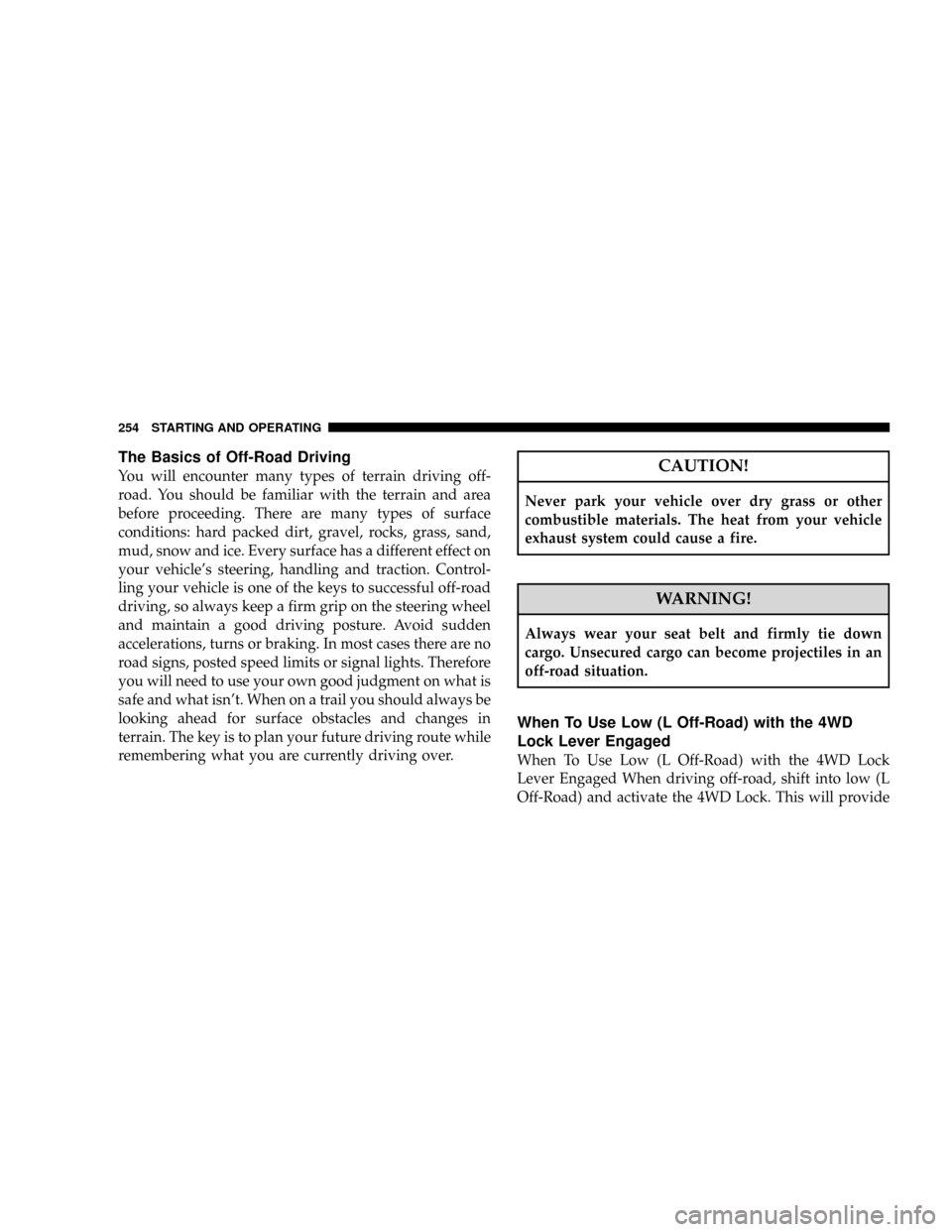
The Basics of Off-Road Driving
You will encounter many types of terrain driving off-
road. You should be familiar with the terrain and area
before proceeding. There are many types of surface
conditions: hard packed dirt, gravel, rocks, grass, sand,
mud, snow and ice. Every surface has a different effect on
your vehicle's steering, handling and traction. Control-
ling your vehicle is one of the keys to successful off-road
driving, so always keep a firm grip on the steering wheel
and maintain a good driving posture. Avoid sudden
accelerations, turns or braking. In most cases there are no
road signs, posted speed limits or signal lights. Therefore
you will need to use your own good judgment on what is
safe and what isn't. When on a trail you should always be
looking ahead for surface obstacles and changes in
terrain. The key is to plan your future driving route while
remembering what you are currently driving over.CAUTION!
Never park your vehicle over dry grass or other
combustible materials. The heat from your vehicle
exhaust system could cause a fire.
WARNING!
Always wear your seat belt and firmly tie down
cargo. Unsecured cargo can become projectiles in an
off-road situation.
When To Use Low (L Off-Road) with the 4WD
Lock Lever Engaged
When To Use Low (L Off-Road) with the 4WD Lock
Lever Engaged When driving off-road, shift into low (L
Off-Road) and activate the 4WD Lock. This will provide
254 STARTING AND OPERATING
Page 256 of 440
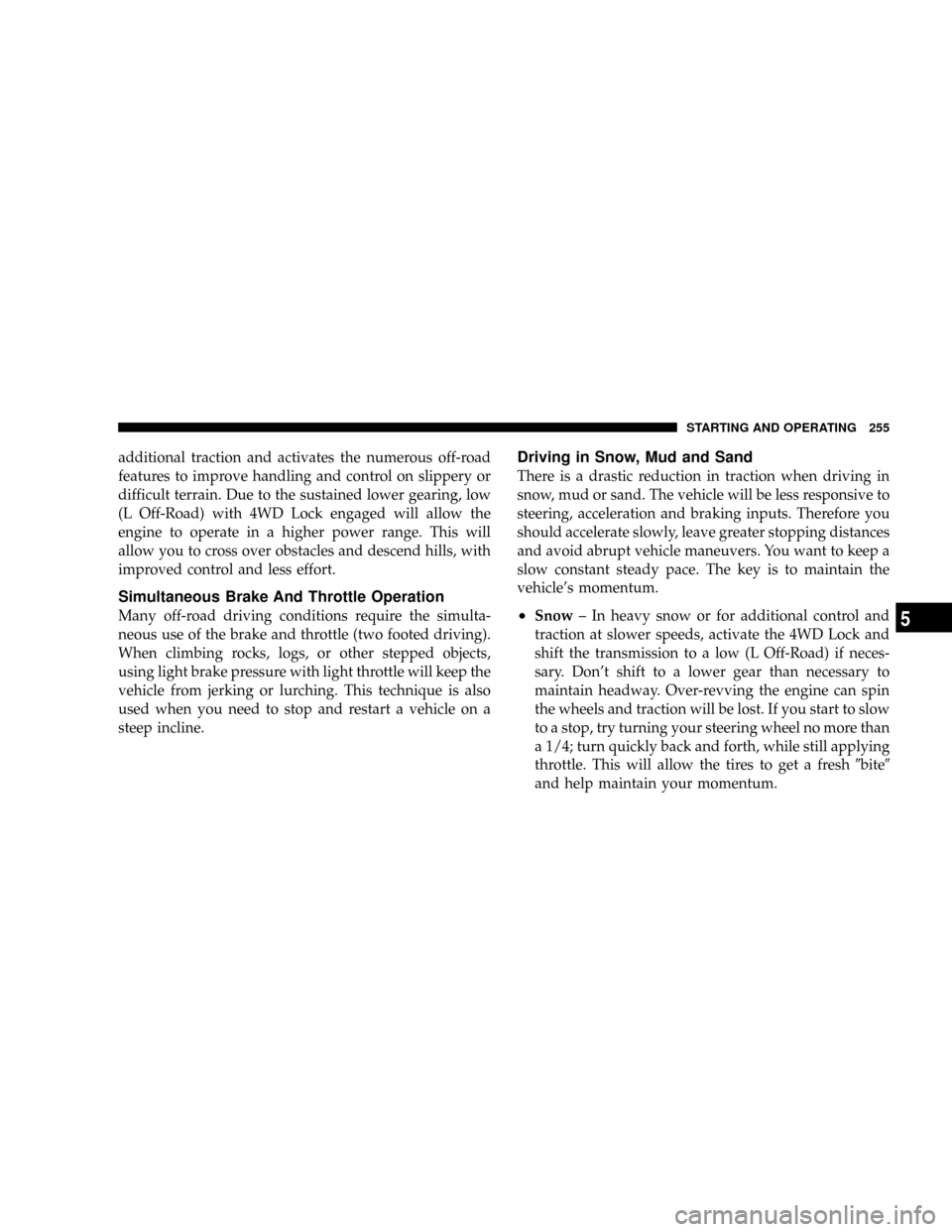
additional traction and activates the numerous off-road
features to improve handling and control on slippery or
difficult terrain. Due to the sustained lower gearing, low
(L Off-Road) with 4WD Lock engaged will allow the
engine to operate in a higher power range. This will
allow you to cross over obstacles and descend hills, with
improved control and less effort.
Simultaneous Brake And Throttle Operation
Many off-road driving conditions require the simulta-
neous use of the brake and throttle (two footed driving).
When climbing rocks, logs, or other stepped objects,
using light brake pressure with light throttle will keep the
vehicle from jerking or lurching. This technique is also
used when you need to stop and restart a vehicle on a
steep incline.
Driving in Snow, Mud and Sand
There is a drastic reduction in traction when driving in
snow, mud or sand. The vehicle will be less responsive to
steering, acceleration and braking inputs. Therefore you
should accelerate slowly, leave greater stopping distances
and avoid abrupt vehicle maneuvers. You want to keep a
slow constant steady pace. The key is to maintain the
vehicle's momentum.
²Snow± In heavy snow or for additional control and
traction at slower speeds, activate the 4WD Lock and
shift the transmission to a low (L Off-Road) if neces-
sary. Don't shift to a lower gear than necessary to
maintain headway. Over-revving the engine can spin
the wheels and traction will be lost. If you start to slow
to a stop, try turning your steering wheel no more than
a 1/4; turn quickly back and forth, while still applying
throttle. This will allow the tires to get a fresh9bite9
and help maintain your momentum.
STARTING AND OPERATING 255
5
Page 257 of 440
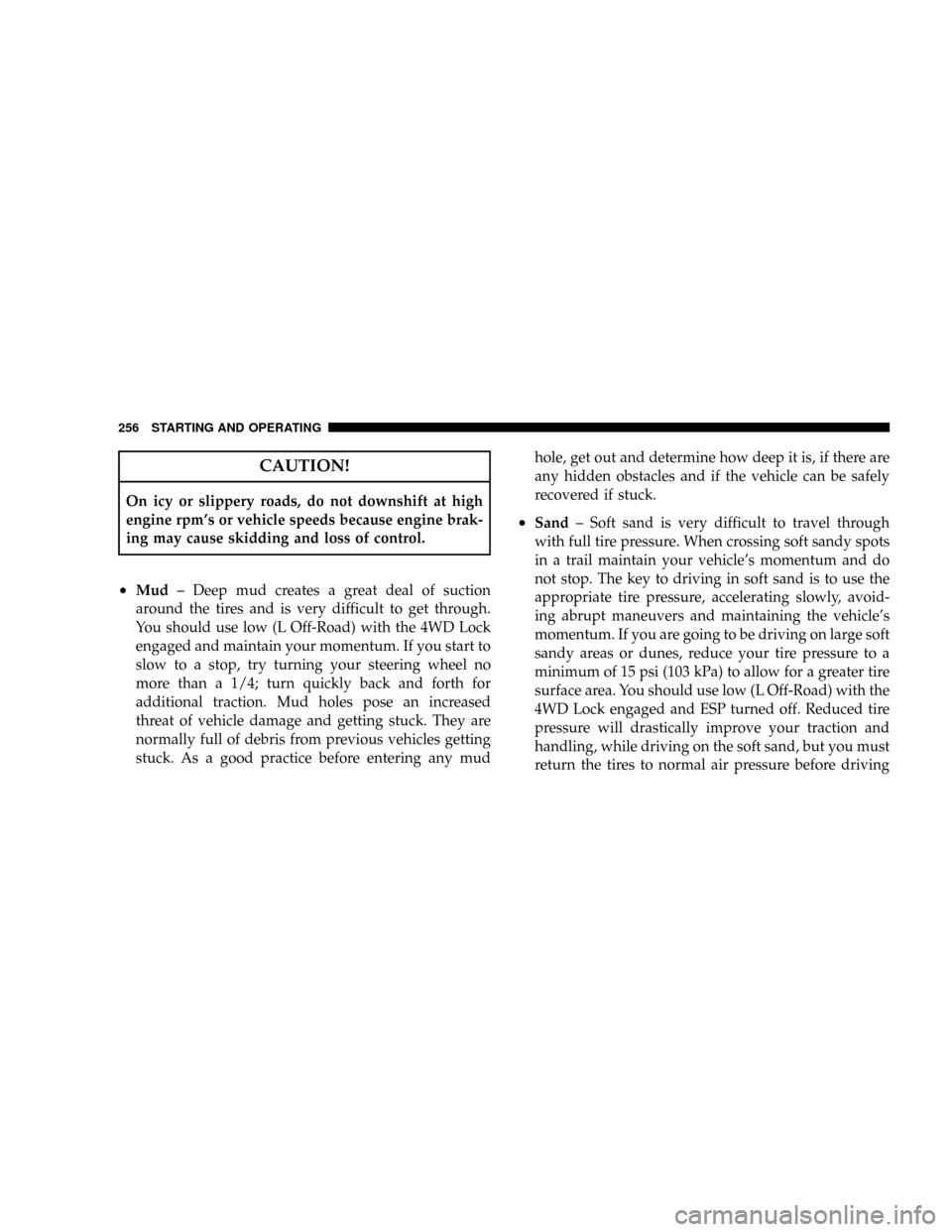
CAUTION!
On icy or slippery roads, do not downshift at high
engine rpm's or vehicle speeds because engine brak-
ing may cause skidding and loss of control.
²Mud± Deep mud creates a great deal of suction
around the tires and is very difficult to get through.
You should use low (L Off-Road) with the 4WD Lock
engaged and maintain your momentum. If you start to
slow to a stop, try turning your steering wheel no
more than a 1/4; turn quickly back and forth for
additional traction. Mud holes pose an increased
threat of vehicle damage and getting stuck. They are
normally full of debris from previous vehicles getting
stuck. As a good practice before entering any mudhole, get out and determine how deep it is, if there are
any hidden obstacles and if the vehicle can be safely
recovered if stuck.
²Sand± Soft sand is very difficult to travel through
with full tire pressure. When crossing soft sandy spots
in a trail maintain your vehicle's momentum and do
not stop. The key to driving in soft sand is to use the
appropriate tire pressure, accelerating slowly, avoid-
ing abrupt maneuvers and maintaining the vehicle's
momentum. If you are going to be driving on large soft
sandy areas or dunes, reduce your tire pressure to a
minimum of 15 psi (103 kPa) to allow for a greater tire
surface area. You should use low (L Off-Road) with the
4WD Lock engaged and ESP turned off. Reduced tire
pressure will drastically improve your traction and
handling, while driving on the soft sand, but you must
return the tires to normal air pressure before driving
256 STARTING AND OPERATING
Page 261 of 440
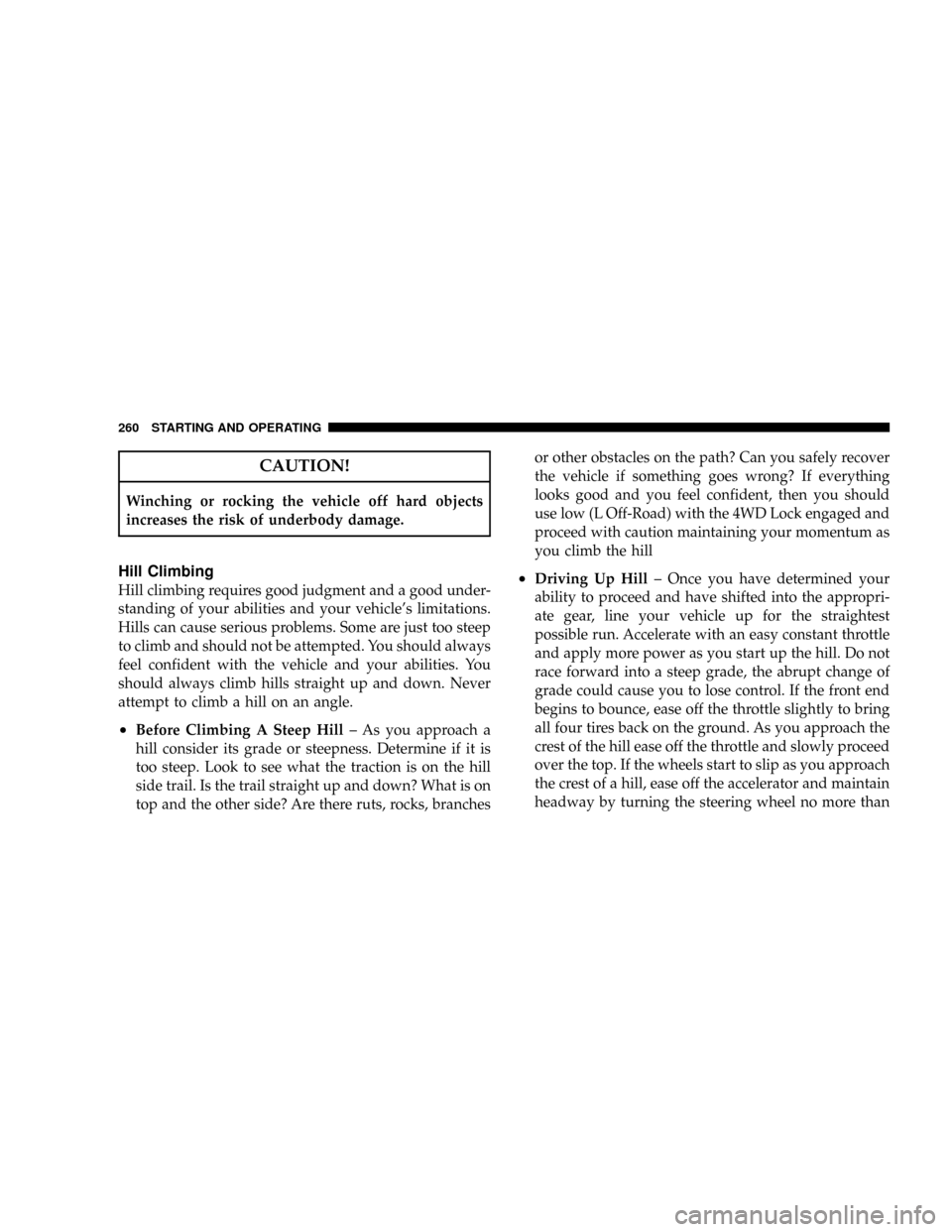
CAUTION!
Winching or rocking the vehicle off hard objects
increases the risk of underbody damage.
Hill Climbing
Hill climbing requires good judgment and a good under-
standing of your abilities and your vehicle's limitations.
Hills can cause serious problems. Some are just too steep
to climb and should not be attempted. You should always
feel confident with the vehicle and your abilities. You
should always climb hills straight up and down. Never
attempt to climb a hill on an angle.
²Before Climbing A Steep Hill± As you approach a
hill consider its grade or steepness. Determine if it is
too steep. Look to see what the traction is on the hill
side trail. Is the trail straight up and down? What is on
top and the other side? Are there ruts, rocks, branchesor other obstacles on the path? Can you safely recover
the vehicle if something goes wrong? If everything
looks good and you feel confident, then you should
use low (L Off-Road) with the 4WD Lock engaged and
proceed with caution maintaining your momentum as
you climb the hill
²Driving Up Hill± Once you have determined your
ability to proceed and have shifted into the appropri-
ate gear, line your vehicle up for the straightest
possible run. Accelerate with an easy constant throttle
and apply more power as you start up the hill. Do not
race forward into a steep grade, the abrupt change of
grade could cause you to lose control. If the front end
begins to bounce, ease off the throttle slightly to bring
all four tires back on the ground. As you approach the
crest of the hill ease off the throttle and slowly proceed
over the top. If the wheels start to slip as you approach
the crest of a hill, ease off the accelerator and maintain
headway by turning the steering wheel no more than
260 STARTING AND OPERATING
Page 262 of 440
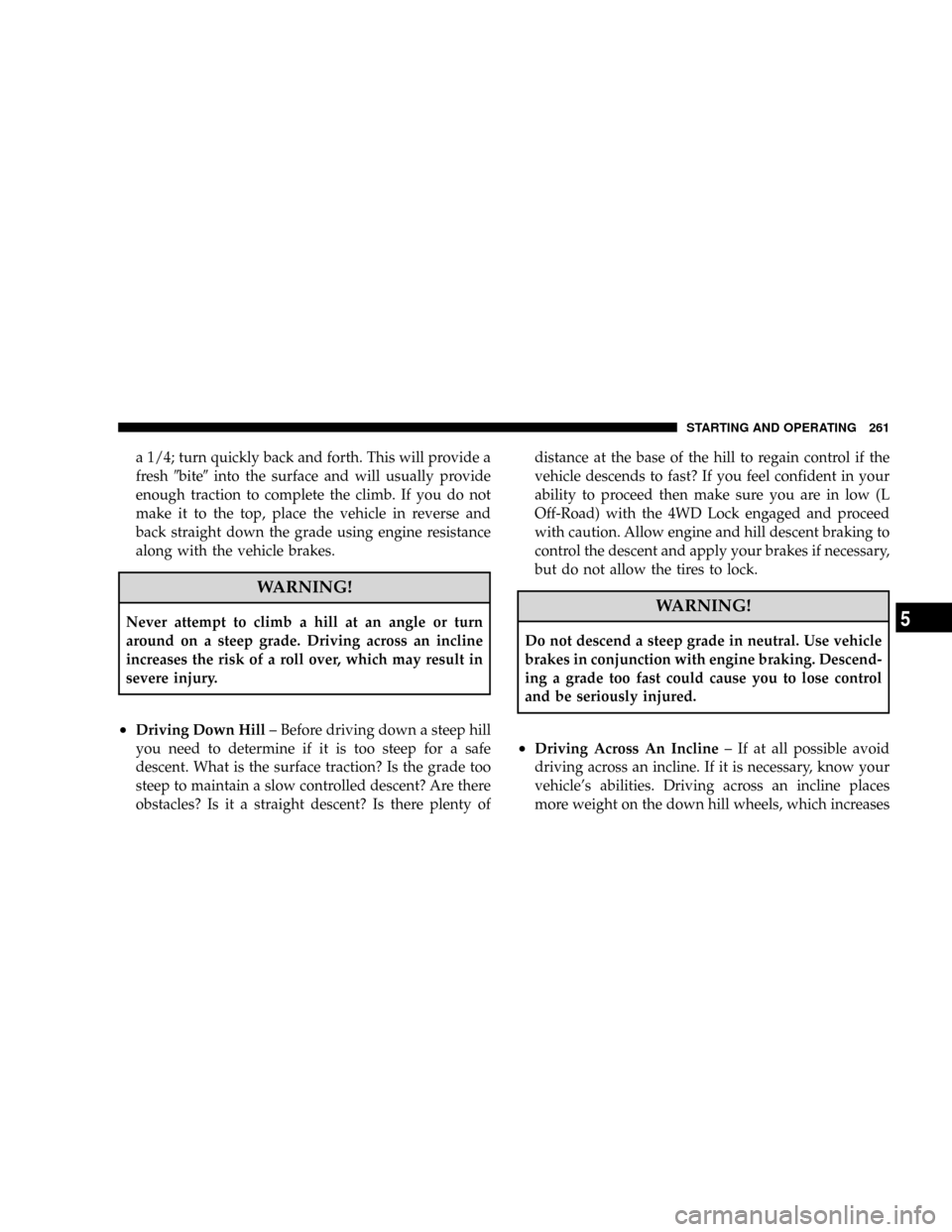
a 1/4; turn quickly back and forth. This will provide a
fresh9bite9into the surface and will usually provide
enough traction to complete the climb. If you do not
make it to the top, place the vehicle in reverse and
back straight down the grade using engine resistance
along with the vehicle brakes.
WARNING!
Never attempt to climb a hill at an angle or turn
around on a steep grade. Driving across an incline
increases the risk of a roll over, which may result in
severe injury.
²Driving Down Hill± Before driving down a steep hill
you need to determine if it is too steep for a safe
descent. What is the surface traction? Is the grade too
steep to maintain a slow controlled descent? Are there
obstacles? Is it a straight descent? Is there plenty ofdistance at the base of the hill to regain control if the
vehicle descends to fast? If you feel confident in your
ability to proceed then make sure you are in low (L
Off-Road) with the 4WD Lock engaged and proceed
with caution. Allow engine and hill descent braking to
control the descent and apply your brakes if necessary,
but do not allow the tires to lock.
WARNING!
Do not descend a steep grade in neutral. Use vehicle
brakes in conjunction with engine braking. Descend-
ing a grade too fast could cause you to lose control
and be seriously injured.
²Driving Across An Incline± If at all possible avoid
driving across an incline. If it is necessary, know your
vehicle's abilities. Driving across an incline places
more weight on the down hill wheels, which increases
STARTING AND OPERATING 261
5